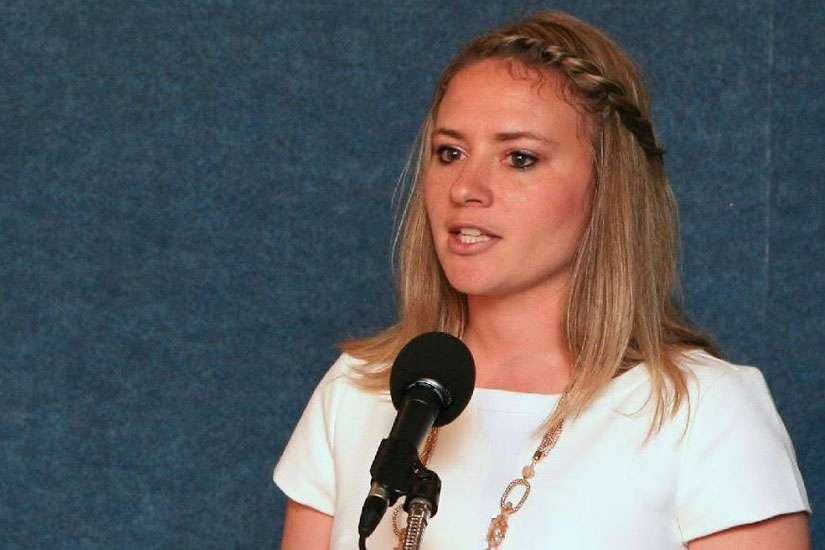But the fight against pornography is not unique to religious organizations.
"This is not a moral issue. We now have science to back this up," said Dawn Hawkins, vice president and executive director of the National Center on Sexual Exploitation.
The centre, an organization founded in 1962 whose mission is "to expose the seamless connection between all forms of exploitation," held a symposium at the U.S. Capitol exposing pornography as a public health crisis, and how porn fuels sex trafficking, child exploitation and sexual violence.
The room overflowed with Capitol Hill congressional staffers, reporters and the general public for an afternoon of speeches.
"There is an overwhelming support for us to address this issue," Hawkins said in her opening remarks that kick-started the day's events. "The fact that this room is overflowing is a wake-up call for Congress."
The speakers -- Ernie Allen, Dr. Sharon Cooper, Melissa Farley, Gail Dines, Dr. Donald J. Hilton, Mary Anne Layden, Ed Smart and Cordelia Anderson -- all discussed research conducted on the negative impacts porn has upon society and how "pornography is one of the root causes of sexual exploitation," said Hawkins.
While none of the presenters cited the source of the statistics they presented, they all are considered experts in the field.
Pornography seems to be everywhere.
Dines, a professor of sociology and women's studies at Wheelock College in Boston, discussed the presence of Internet porn.
Thirty-six per cent of content on the Internet is pornographic, she said, and online porn brings in total revenue of $3,000 per second. On average, one out of every four Internet searches is about porn.
"Pornography is the public health crisis of the digital age," she said.
Anderson, founder of Sensibilities Prevention Services, a Minnesota-based training and consultation business, expressed similar beliefs and explained why she and Dines believe there is a public health crisis.
In the past 20 years, she said, there has been a transition from soft porn and Playboy magazines, to graphic, violent Internet porn, and the age group of those viewing porn has expanded to include younger and younger children. "When content changes, as content has, and the reach changes as it has, we have the largest, unregulated social experiment ever," Anderson stated.
Dines stated that everything associated with hate, disrespect and dehumanization is why porn has taken the place of intimacy.
"Porn is about making hate to women," she argued.
Next up was Hilton, a neurosurgeon from the University of Texas, who presented evidence of the impact pornography can have on the human brain.
"Pornography is associated with shrinkage in the brain's key reward areas," he said.
The more pronounced pornography usage, the more shrinkage occurs in that area of the brain that occurs, he said, explaining that the brain is the source of behaviour, but it is modified by the behaviour it produces.
Pornography isn't merely harmful to women and the brains of the users, but also to children.
According to Cooper, who is CEO of Development and Forensic Pediatrics, believes that there are a lot of ways that porn can be harmful to children. She connected the viewing of porn to potential pedophilia.
"We see children harmed when adults use child porn as a plan of action for abuse against children," she said.
Another way that children can be affected, she said, was through forced viewing of adult pornography.
"Sometimes adults show youth porn to seduce them," she said.
Farley, executive director of Prostitution Research and Education, thinks that "the sex industry also harms the rest of us," adding that "sexual entrepreneurs count on our tolerance."
She pleaded with the audience to "not mystify the sex industry. The real lives of those who are trafficked or prostituted are often indisputable from those who are victims of violence."
In discussing victims of violence, Layden, director of the sexual trauma and psychopathology program in the Center for Cognitive Therapy at the University of Pennsylvania, spoke about college-age female victims.
She stated that 25 per cent of college women experience a rape or attempted rape, and that women who are exposed to porn as young girls are more likely to feel negatively about their bodies, have less support for women's equality, and are more likely to think that rapists deserve less time in prison.
Following the experts was a father -- Ed Smart, whose daughter Elizabeth was abducted and raped at age 14. She was held for nine months; the case made national headlines. He spoke about his daughter's abductor, Brian David Mitchell, and how he had been first exposed to porn at a young age by his own father.
"Porn provides the slippery slope to abuse," he said.
While porn has a vast array of negative effects on society, there are solutions, but the "solutions are tough," said Ernie Allen, former president and CEO of the National Center for Missing & Exploited Children. "I am a lawyer, and I believe in free speech, but this content is not protected under the first amendment."
Allen called upon Congress to pass legislation to curb the availability of graphic online pornography.


